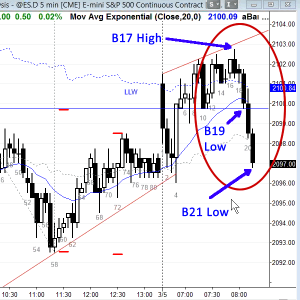BPA trading room discussion: March 5, 2015
Discussion during webinar after potential first leg of bear channel was forming at about 08:11 PST. Al talked about trade management – in particular position sizing considerations – for traders who were scalping or swinging a trade from the start of the bear leg.
Audio duration: 2min 45sec — Scroll down for image
Audio transcript
17 ticks below the 17 low – 18 ticks now. I think you definitely have to take at least part off, if not all off if you did short up there (top of bear leg).
Think about this for a second. Let’s say a trader shorted up here (B16 close), and they took a big enough position size so that they could risk 2 points. Now let’s say their stop is still up here (above B17). So now they are risking 4 points. What do they do? They have to reduce their position size. Their maximum risk on a full position is 2 points, and now their stop is 4 points away, they have to reduce their position size.
And the institutions trade that way as well. They have a maximum risk on every trade, and once it is exceeded they reduce their position size. And that’s what causes pullbacks, that’s why you have a strong move and then you get a pullback. It’s because you have a lot of institutions with big open profits but the stop is now far away. So their risk is big and they have to get down to a position size that is appropriate for that risk.
Let’s say you get a little pullback, and then the bears short again on the resumption down. Well, then once you get a new low you have a new stop that is not as far as the current stop, so then you can be back to trading a full position. So whenever you get your magic number, like 4 points, double, so the stop is 4 points away, especially on a day like this where you get a lot of two-sided trading, you are going to get profit taking because the stop is up here (top of bear leg). Instead of 2 points you are now risking 4 points and you cannot trade a full size if you are now risking 4 points.
You can say, “Well Al it’s not really my money. It’s somebody else’s money. I bought up here so my account size is really from over here.” No, the money is in your account and as soon as it is in your account, every tick is yours. Every tick you lose is yours – it’s your money. It drives me angry when I hear people who claim to be experts talk about “oh, you are trading other people’s money with a big open profit.” No, it’s your money. To me it never matters where you enter. All that matters is the current price and the current price action. So it does not matter whether you shorted up here (B16/17), you shorted there (B19), you shorted there (B20), you manage all of those trades the same.
If you are scalping you have already scalped out. If you are swing trading, it does not matter if you sold right here (B21 Low). The management is still the same, if you took that trade for a swing, your swing stop is up here (above B20). If you shorted over here for a swing (below B17), your swing stop is up here (above B17). So it does not matter where you entered, your management is based upon the current price action.
Al Brooks
Information on Al’s Online day trading room


